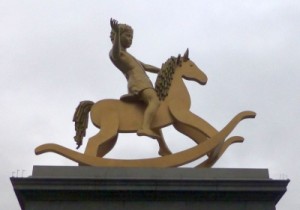Philip Davies has written a book titled Lost London (2009). It consists mainly of early 20th-century photos of buildings destroyed by new urban development and road and building projects. The final section shows buildings, including many churches, destroyed by Nazi V1 and V2 rockets during WWII. The destruction of the Oxford Arms in 1878 gave rise to the city’s first historical preservation organization. Since 1947 the Town and Country Planning Act has helped protect historic buildings.
Parts of London continue to disappear, and the debate over preservation versus business progress continues. Two recent examples of Lost London appear below. The large boy on a rocking horse stood atop the 4th plinth in Trafalgar Square in 2013. It disappeared overnight, now having been replaced by the big blue chicken. That site is reserved for temporary art, so such disappearance is predictable.
In April 2012, a statue of Genghis Khan was installed next to the Marble Arch. The 16 ft-high bronze attracted praise for its creativity and novelty, and criticism for commemorating a bloodthirsty tyrant. Notice the fanciful nature of his horse! We observed and photographed the statue in July 2013, but today all that remains is a pot of gravel. I can find no record from Internet sources of its removal. Did the critics win?
Like the buildings, London’s people have come and gone as well. The Brick’s Lane area of East London [Spitalfieldshas been populated by French Huguenots in the earl y 1800s, Central European Jews in the 1890s,and Bengalis in the 1970s So as you explore London, be aware that what you observe may also be lost– cherish and remember your experiences!


Comments by Slatta